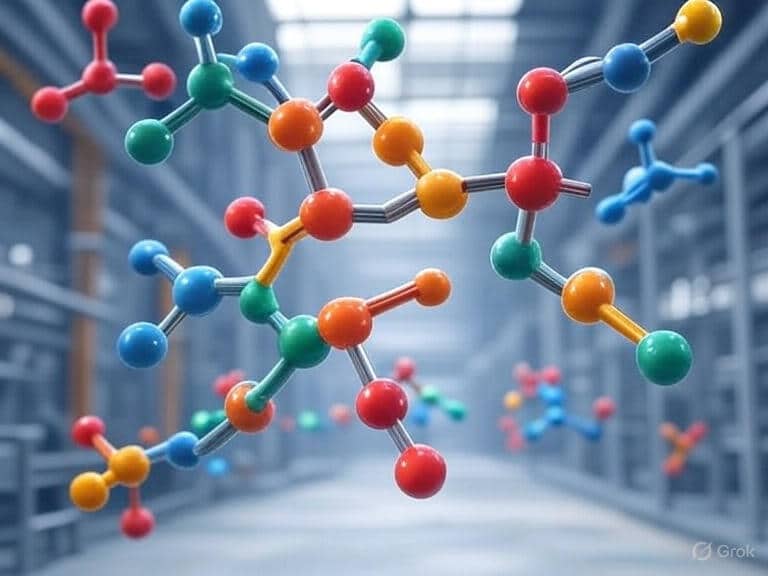hcooch ch2 h2o: A Deep Dive into Its Chemistry and Applications

The query references “hcooch ch2 h2o,” which appears to be a misrepresentation of methyl formate (HCOOCH₃) and its interactions with water (H₂O). I’ll assume you’re asking about methyl formate and its chemistry, applications, and interactions with water, as this aligns with the provided outline and search results. Methyl formate, a simple ester, is a fascinating compound with a wide range of industrial and laboratory uses. Let’s dive into its chemistry, applications, and more, following your outline with a conversational, engaging tone.
Fundamentals of Methyl Formate
Methyl formate, also known as methyl methanoate, is the simplest carboxylate ester, formed from methanol and formic acid. This colorless liquid boasts an ethereal odor, high vapor pressure, and low surface tension, making it a versatile player in chemical processes. Its molecular formula, C₂H₄O₂, hides a surprising reactivity that makes it a cornerstone in C1 chemistry, acting as a building block for over 50 chemicals. Unlike complex molecules, its simplicity—think of it as the minimalist of esters—belies its importance in industries ranging from pharmaceuticals to refrigeration. Its solubility in water (230 g/L at 25°C) sets the stage for unique interactions, which we’ll explore further.
Key Concepts of Methyl Formate
Picture methyl formate as a chemical Swiss Army knife. Its high vapor pressure makes it ideal for quick-drying finishes, while its reactivity with water leads to hydrolysis, producing methanol and formic acid. This reaction is slow but significant, as both products have their own industrial uses. Methyl formate’s role as a hydrogen carrier is gaining traction, offering a carbon-neutral alternative for energy storage. Its low boiling point (31.5°C) and flammability (flash point -19°C) demand careful handling, but these traits also make it a go-to for applications like foam blowing agents, replacing harmful CFCs. Its versatility stems from its ability to act as both a solvent and a reactive intermediate.
Molecular Structure of Methyl Formate
Methyl formate’s structure is elegantly simple: a carbonyl group (C=O) bonded to a methoxy group (O-CH₃) and a hydrogen atom. The carbon-oxygen double bond in the carbonyl is the heart of its reactivity, while the methoxy group adds stability. In water, methyl formate’s polar carbonyl interacts with water’s hydrogen bonds, leading to partial solubility. Imagine water molecules cozying up to the carbonyl oxygen, forming weak interactions that can trigger hydrolysis under the right conditions. This structure also explains its low boiling point, as weak intermolecular forces allow it to vaporize easily.
Visualizing Methyl Formate-Water Interactions
Think of methyl formate in water like a shy guest at a party—it mingles but doesn’t fully blend. Its solubility (230 g/L) allows it to dissolve moderately, but over time, it reacts slowly to form methanol and formic acid. Infrared spectroscopy studies reveal how water’s O-H bonds interact with methyl formate’s carbonyl, creating a dynamic dance of hydrogen bonding. This interaction is key in processes like hydrolysis, where water molecules nudge the ester bond, breaking it apart. Visualizing this at a molecular level, picture water molecules clustering around the polar carbonyl, gently tugging at the ester linkage until it yields.
Reactivity Patterns of Methyl Formate
Methyl formate is like a chemical chameleon, adapting to various reactions with ease. Its carbonyl group makes it reactive in hydrolysis, aminolysis, and carbonylation processes. For example, in the presence of a strong acid, it hydrolyzes to methanol and formic acid, a reaction that’s slow but steady in neutral water (half-life of 2.19 days at pH 7). It also undergoes aminolysis to produce formamide or dimethylformamide, key solvents in polymer chemistry. Its reactivity with alcohols or olefins can form complex esters, showcasing its role as a versatile intermediate in organic synthesis.
Typical Reactions Involving Methyl Formate
Let’s break down some reactions. Hydrolysis is a classic: HCOOCH₃ + H₂O → HCOOH + CH₃OH. This reaction, catalyzed by acids or bases, is crucial for producing formic acid industrially. Another gem is aminolysis, where methyl formate reacts with ammonia to form formamide (HCOOCH₃ + NH₃ → HCONH₂ + CH₃OH), a solvent used in pharmaceuticals. In carbonylation, methanol and carbon monoxide combine to form methyl formate, a process BASF has perfected with 96% selectivity. These reactions highlight why methyl formate is a workhorse in chemical synthesis, transforming into valuable products with the right nudge.
Industrial Applications of Methyl Formate
Methyl formate powers industries in surprising ways. It’s a precursor to formic acid, formamide, and dimethylformamide, which are used in textiles, pharmaceuticals, and polymer production. Its high vapor pressure makes it a stellar solvent for nitrocellulose and cellulose acetate, creating quick-drying finishes for coatings. In the foam industry, it’s a blowing agent in products like Ecomate®, replacing ozone-depleting CFCs with zero ozone depletion potential. It also serves as a fumigant for tobacco and grains, and in pharmaceuticals, it’s a raw material for drugs like sulfonic acid methyl pyrimidine. Global production exceeds 6 million tons annually, underscoring its industrial might.
How Methyl Formate Powers Manufacturing
In manufacturing, methyl formate is a quiet hero. Its role in formic acid production via hydrolysis (80% of global formic acid comes from this route) supports industries like leather tanning and food preservation. In the Kemira-Leonard process, methyl formate is hydrolyzed at mild conditions (80°C, 3 atm) to yield 85% pure formic acid. It’s also a key player in producing high-purity carbon monoxide for chemical synthesis. As a hydrogen carrier, it’s being explored for fuel cells, offering faster hydrogen release than methanol or formic acid, with turnover frequencies exceeding 44,000 h⁻¹ under mild conditions.
Laboratory Techniques with Methyl Formate
Working with methyl formate in the lab is like handling a spirited horse—manageable with care. It’s synthesized via esterification of methanol and formic acid over a desiccant like calcium chloride, which prevents water interference. Fractional distillation purifies it, leveraging its low boiling point (32°C). For hydrolysis experiments, researchers use strong acids to accelerate the reaction, monitoring products with gas chromatography. Safety is critical: its low flash point (-19°C) means no open flames, and its ethereal vapors require well-ventilated fume hoods to avoid inhalation risks.
Practical Protocols
Here’s a simple lab protocol for synthesizing methyl formate: Combine anhydrous formic acid and dry methanol in a 1:1 molar ratio with calcium chloride as a desiccant. Heat gently, avoiding sulfuric acid, as it can decompose formic acid to carbon monoxide. Distill the mixture to collect methyl formate at 32°C, then dry with anhydrous magnesium sulfate to remove residual water. For hydrolysis studies, mix methyl formate with water in a controlled pH environment (e.g., pH 7) and analyze products using HPLC or IR spectroscopy to track formic acid formation. Always wear PPE, including gloves and goggles, to handle its flammable and irritant nature.
Methyl Formate Synthesis Protocol
Materials
- Anhydrous formic acid (98% purity)
- Dry methanol (99.8% purity)
- Calcium chloride (anhydrous, as desiccant)
- Anhydrous magnesium sulfate (for drying)
- Round-bottom flask, condenser, distillation setup
- PPE: gloves, goggles, lab coat
Procedure
- In a fume hood, combine 46 g (1 mol) anhydrous formic acid and 32 g (1 mol) dry methanol in a 250 mL round-bottom flask.
- Add 10 g anhydrous calcium chloride to absorb water and act as boiling chips.
- Attach a condenser and heat gently (40–50°C) for 2 hours, avoiding rapid boiling to prevent bumping.
- Distill the mixture, collecting the fraction at 31–32°C to obtain crude methyl formate.
- Dry the distillate with 5 g anhydrous magnesium sulfate for 30 minutes, then filter.
- Store in a sealed, dry container in a flammable storage cabinet.
Safety Notes
- Conduct in a well-ventilated fume hood to avoid inhaling vapors.
- Avoid open flames due to low flash point (-19°C).
- Wear PPE to prevent skin/eye irritation from contact.
Environmental and Safety Considerations for Methyl Formate
Methyl formate’s flammability and toxicity demand respect. Its vapors, heavier than air, can travel to ignition sources, risking flash fires. Inhalation of high concentrations (10,000 ppm for 1 hour) may cause respiratory distress or visual disturbances, and prolonged exposure can lead to narcosis. It’s water-soluble, reacting slowly to form formic acid (corrosive) and methanol (flammable), which can impact aquatic ecosystems if spilled. Its short atmospheric life (3 days) and zero ozone depletion potential make it environmentally friendlier than CFCs, but careful handling is essential to prevent workplace hazards.
Mitigating Risks of Methyl Formate
To keep risks in check, store methyl formate in approved flammable liquid cabinets, away from ignition sources. Use Tychem® or Tyvek® PPE to prevent skin and eye contact, as it can irritate mucous membranes. In case of spills, isolate the area for 50 meters and use alcohol-resistant foam for firefighting, as water sprays may be inefficient. For first aid, wash contaminated skin immediately and seek medical attention for inhalation exposure. Proper ventilation and training on handling procedures are non-negotiable to ensure safety in labs and industrial settings.
Emerging Research Trends for Methyl Formate
The future of methyl formate is buzzing with potential. Researchers are exploring its role as a hydrogen carrier for fuel cells, with catalysts like copper chromite enabling high-efficiency dehydrogenation at low temperatures (<90°C). Innovations like the coal-to-methyl-formate (CTMF) process by the Fujian Institute use heterogeneous nanocatalysts for greener production from coal-based syngas. Photocatalytic methods, such as Bi-doped TiO₂ for methanol oxidation, promise sustainable synthesis routes. Metal-organic frameworks (MOFs) are also being studied for water interactions, potentially enhancing methyl formate’s use in wastewater treatment or gas storage.
The Future of Methyl Formate Science
Looking ahead, methyl formate could redefine green chemistry. Advances in CO₂ hydrogenation to produce methyl formate directly from carbon dioxide are gaining traction, offering a carbon-neutral pathway. MOF-based catalysts are being tailored for selective adsorption, potentially revolutionizing water-related applications like desalination. The push for heterogeneous catalysts over homogeneous ones aims to simplify industrial processes, reducing costs and environmental impact. As research unravels its reactivity at the molecular level, methyl formate’s role in sustainable energy and chemical synthesis is set to grow, making it a compound to watch.
Conclusion
Methyl formate is more than a simple ester—it’s a powerhouse in C1 chemistry, driving industries from pharmaceuticals to renewable energy. Its interactions with water, while slow, unlock valuable products like formic acid, while its high vapor pressure and reactivity make it a versatile solvent and intermediate. With careful handling to mitigate its flammability and toxicity, it’s a safe bet for labs and factories. Emerging trends, from hydrogen storage to greener synthesis, signal a bright future. Whether you’re a chemist or an industry buff, methyl formate’s blend of simplicity and potential is sure to spark curiosity.

James Carter is an experienced content creator specializing in lifestyle and technology. With over a decade of writing for reputable blogs, he delivers well-researched, engaging articles. James holds a degree in Communications and is passionate about sharing expert insights, ensuring credibility and value for DriveMad’s readers.






